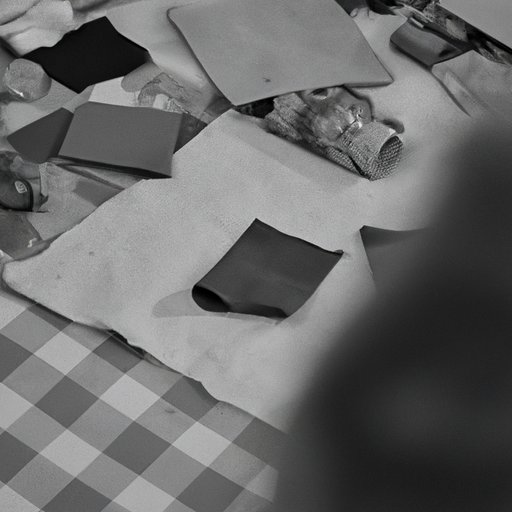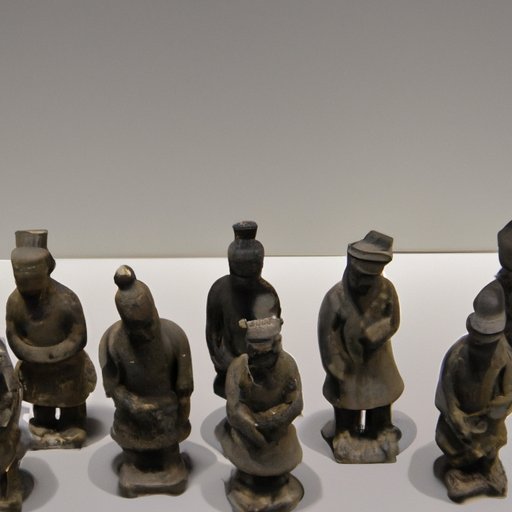Introduction
Material culture is an important concept in anthropology, sociology and other social sciences. It is defined as the physical objects, practices and artifacts that are used by people in their everyday lives. This includes everything from clothing and jewelry to furniture and tools. It is an important part of understanding how culture and societies develop and evolve over time. In this article, we will explore material culture, its meaning and its impact on society.

An Overview of Material Culture: Defining and Exploring Its Meaning
Material culture can be defined as the tangible things that people use on a day-to-day basis. This includes not only physical objects, but also practices, rituals and artifacts. According to anthropologist Alfred Kroeber, “Material culture consists of the objects, products and structures made, used and shared by members of a particular culture.”
The concept of material culture has been around for centuries. Ancient civilizations used material culture to express their beliefs, values and ideas. For example, the ancient Egyptians used material culture to create elaborate tombs and monuments. The Romans used material culture to build grand civic spaces such as the Colosseum. Even today, material culture is still being used to communicate cultural beliefs and values.
Material culture can take many forms. It includes items like clothing and jewelry, furniture and tools, art and literature, and even technology and media. Each type of material culture has its own unique history and meaning. By exploring these different types and forms of material culture, we can gain insight into the beliefs and values of different cultures.

A Study of the Influence of Material Culture on Society
Material culture plays an important role in everyday life. It helps to shape our identities, our relationships with others and our sense of belonging in society. It can also have a significant impact on social change. In order to better understand the influence of material culture on society, it is important to examine its role in everyday life and its impact on social change.
Examining the Role of Material Culture in Everyday Life
Material culture has a profound influence on our daily lives. It is used to communicate our values and beliefs, to express our personalities and to create meaningful connections with others. Our choices of material culture often reflect our individual identities and our place in society. As sociologist Pierre Bourdieu explains, “The objectification of social relations in objects is an essential feature of material culture.”
In addition to expressing our individual identities, material culture can also be used to communicate shared values and beliefs. For example, religious symbols and artifacts can be used to communicate shared spiritual beliefs. Artifacts such as flags and national symbols can be used to communicate shared national pride. These shared values and beliefs are often communicated through the use of material culture.

Investigating the Impact of Material Culture on Social Change
Material culture can also have a significant impact on social change. It can be used to challenge existing power structures and to foster new ideas and perspectives. For example, during the civil rights movement, African Americans used material culture such as buttons, posters and banners to promote their cause. Similarly, during the women’s rights movement, feminists used material culture such as buttons and posters to challenge traditional gender roles.
Material culture can also be used to create new social norms and practices. For example, during the 19th century, the invention of the bicycle helped to redefine gender roles and create new opportunities for women. Similarly, the invention of the automobile helped to create new forms of leisure and recreation, as well as new forms of transportation.
Exploring the Different Types and Forms of Material Culture
Material culture can take many forms, including objects, practices and artifacts. Objects such as clothing and jewelry, furniture and tools, books and magazines, and technology and media are all examples of material culture. Practices such as rituals, ceremonies and festivals are also examples of material culture. Finally, artifacts such as monuments and sculptures are also examples of material culture.
By examining the different types and forms of material culture, we can gain insight into the beliefs and values of different cultures. We can also gain insight into how material culture has changed over time and how it has impacted social and historical change.
Conclusion
Material culture is an important concept in anthropology, sociology and other social sciences. It is defined as the physical objects, practices and artifacts that are used by people in their everyday lives. By examining the different types and forms of material culture, we can gain insight into the beliefs and values of different cultures. We can also gain insight into how material culture has changed over time and how it has impacted social and historical change.
Material culture plays an important role in everyday life. It helps to shape our identities, our relationships with others and our sense of belonging in society. It can also have a significant impact on social change. In order to better understand the influence of material culture on society, it is important to examine its role in everyday life and its impact on social change.
In conclusion, material culture is an important concept in understanding how culture and societies develop and evolve over time. By exploring the different types and forms of material culture, we can gain insight into the beliefs and values of different cultures and how it has impacted social and historical change.
Recommendations for Further Research
Further research is needed to better understand the influence of material culture on society. For example, more research is needed to examine the different types and forms of material culture and the ways in which they have impacted social and historical change. In addition, further research is needed to understand the role of material culture in shaping individual identities and forming meaningful connections with others.
Conclusion
In conclusion, material culture is an important concept in understanding how culture and societies develop and evolve over time. By exploring the different types and forms of material culture, we can gain insight into the beliefs and values of different cultures and how it has impacted social and historical change. Through further research, we can gain a deeper understanding of the role of material culture in everyday life and its impact on social change.
(Note: Is this article not meeting your expectations? Do you have knowledge or insights to share? Unlock new opportunities and expand your reach by joining our authors team. Click Registration to join us and share your expertise with our readers.)
